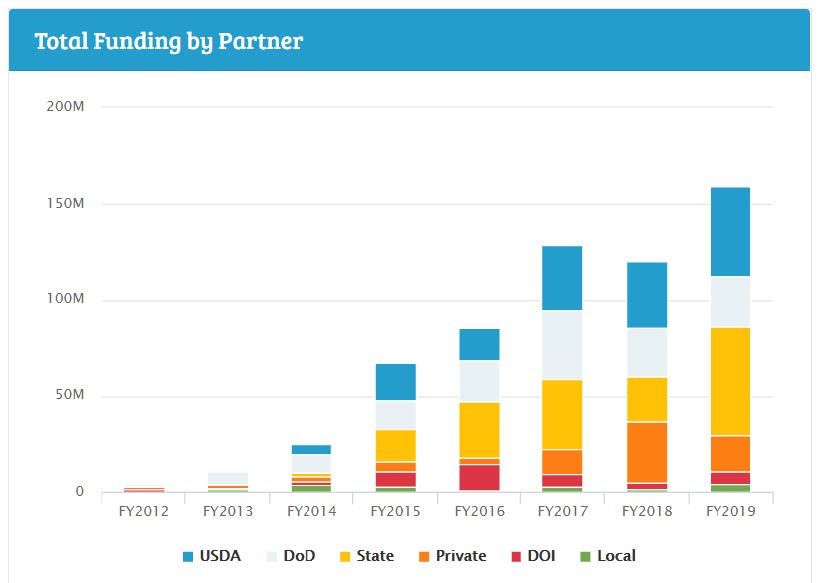Other funding sources are available to military natural resources managers, including research grants, cooperative partnerships with other government agencies, and cooperative agreements with nongovernmental organizations. The Sikes Act grants authority for the DoD to enter into cooperative agreements with nongovernmental organizations. One good source of information is the “DoD Natural Resources Funding Manual” (USAEC 2009). The manual provides descriptions and links to key grant and partnership opportunities and programs from federal, nonfederal and state sources. For example, the National Fish and Wildlife Foundation builds partnerships between leading U.S. corporations and federal agencies, nonprofits and individuals who drive conservation efforts across the United States. Funds for species conservation or habitat restoration on installations may be available through state wildlife or natural resources agencies. DoD and military service FWS liaisons and state and regional FWS staff can help installations find sources of additional funding for base biodiversity conservation projects. There is a wide variety of mostly private and state funding sources to help support installation game and fish objectives.
Inventories of installation biological resources often reveal hotspots of diversity and rarity at various ecological scales (see Chapters 1, 2 and 8). These inventories and other projects attract scientific researchers eager to access military installations to conduct research, apply and test new approaches, and address knowledge gaps. Academic researchers often bring their own funding to the table, and work with installation managers to address questions that are of mutual interest.
Private conservation organizations, such as The Nature Conservancy, may not be able to bring money to the table, but they may be willing to provide in-kind assistance for projects considered mutually beneficial. Several notable grant sources that focus on military lands are described below:
DoD Legacy Program (https://www.denix.osd.mil/legacy/home/)
In 1990, Congress passed legislation establishing the Legacy Resource Management Program to provide financial assistance to the DoD for installationspecific efforts to preserve our natural and cultural heritage. In 1996, the Legacy Resource Management Program was significantly amended by the National Defense Authorization Act, Public Law 104-201, Section 2694 of title 10 to focus on DoD-wide national and regional projects. The program assists DoD in protecting and enhancing resources while enabling military readiness. A Legacy project may involve regional ecosystem management initiatives, habitat preservation efforts, archaeological investigations, invasive species control, Native American consultations, and/or monitoring and predicting migratory patterns of birds and animals, and other projects.
Three principles guide the Legacy program: stewardship, leadership, and partnership.
Stewardship initiatives assist DoD in safeguarding its irreplaceable resources for future generations. By embracing a leadership role as part of the program, the Department serves as a model for respectful use of natural and cultural resources. Through partnerships, the program strives to access the knowledge and talents of individuals outside of DoD.
Peak funding levels approached $50 million in the late 1990s, and annual funding is currently less than $3 million. When originally established in Fiscal Year 1991, the Legacy Program provided funding for specific projects on individual installations. For some years now, Legacy funding has focused on demonstration projects that have broad regional, military service, or DoD-wide applicability that could benefit multiple installations or sensitive natural or cultural resources.
The Strategic Environmental Research and Development Program (SERDP) (http://www.serdp.org/Funding)
The SERDP is DoD’s environmental science and technology program, planned and executed in partnership with the Department of Energy and the Environmental Protection Agency, with participation by numerous other federal and non-federal organizations. It addresses the highest priority issues confronting the military services. Currently funded at about $60 million per year, this program focuses on applying innovative technologies and approaches to support long-term sustainability of DoD’s testing and training ranges while working to significantly reduce current and future environmental liabilities.
Environmental Security Technology Certification Program (ESTCP) (http://www.estcp.org)
The ESTCP goal is to demonstrate and validate promising, innovative technologies that target the most urgent environmental needs of the DoD. The program is currently funded at about $40 million per year. These technologies provide a return on investment through cost savings and improved efficiency. The current cost of environmental remediation and regulatory compliance in the Department is significant. Innovative technology offers the opportunity to reduce costs and environmental risks. ESTCP offers funding in the following four focus areas: Environmental Restoration, Munitions Management, Sustainable Infrastructure (including natural resources/training infrastructure), and Weapons Systems and Platforms.
Partnership Funding
There are numerous programs that provide funding through partnership agreements. The Readiness and Environmental Protection Integration (REPI) Program, Army Compatible Use Buffer Program (ACUB) and Sentinel Landscapes Program, which provide funding to manage sources of encroachment on military lands outside installation boundaries, are discussed in Chapter 6, “Partnerships to Achieve Conservation Goals and Sustain Training.”
The REPI program provides the lion’s share of partnership funding benefitting installations through encroachment management (Figure 7.1). For example, from fiscal year (FY) 2012 through FY 2019, over $141 million in DoD funds, $223 million in Department of Agriculture (USDA) funds, $41 million in Department of the Interior (DOI) funds, $169 million in state funds, $15 million in local funds, and $80 million in private funds have supported projects across seven sentinel landscapes under the Sentinel Landscapes Partnership (see Chapter 6 for more details).

Next Page: Staffing Options
Author
David S. Jones, RA IV, Ecologist/Project Manager
Center for Environmental Management of Military Lands
Warner College of Natural Resources
Colorado State University
